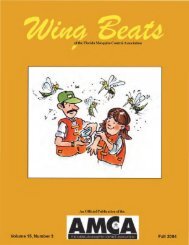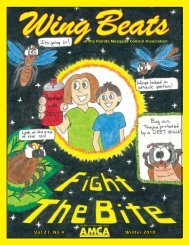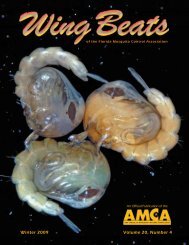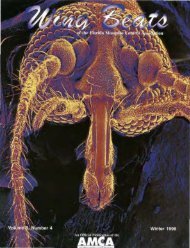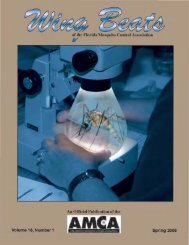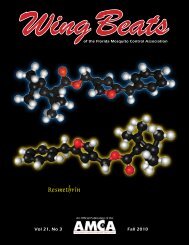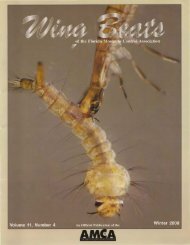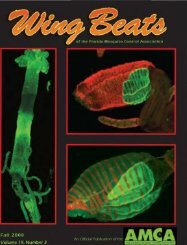Volume 23 Number 1 - Wing Beats - Wing Beats - Florida Mosquito ...
Volume 23 Number 1 - Wing Beats - Wing Beats - Florida Mosquito ...
Volume 23 Number 1 - Wing Beats - Wing Beats - Florida Mosquito ...
Create successful ePaper yourself
Turn your PDF publications into a flip-book with our unique Google optimized e-Paper software.
6<br />
Figure 2: Close-up of Culex iolambdis feeding on a turtle, the <strong>Florida</strong><br />
Red-bellied Cooter, Pseudemys nelsoni.<br />
such as ability to detect certain<br />
host cues, preference in flight<br />
height, size of proboscis or other<br />
body parts, etc. In some environments,<br />
amphibians account<br />
for a large percentage of the<br />
vertebrate biomass, so it is not<br />
surprising that mosquitoes have<br />
adapted to this blood source.<br />
One adaptation which has been<br />
discovered in several of these<br />
frog-biting specialists is an attraction<br />
to the sound of calling<br />
male frogs. The following frogbiting<br />
species are arranged from<br />
generalist to specialist.<br />
Culex iolambdis<br />
This tropical species is found in<br />
southern <strong>Florida</strong>, the Caribbean<br />
and in Central and northern<br />
South America. Along with a<br />
number of other Culex species<br />
in <strong>Florida</strong>, it is a member of the<br />
Spring 2012 <strong>Wing</strong> <strong>Beats</strong><br />
subgenus Melanoconion. This<br />
group includes a number of<br />
small, dark mosquitoes which<br />
have often been recorded feeding<br />
on cold-blooded animals.<br />
In 1979, John Edman reported<br />
on the <strong>Florida</strong> blood meal hosts<br />
of five species of Melanoconion<br />
mosquitoes, three of which<br />
(Culex opisthopus, Cx peccator,<br />
and Cx pilosus) were found to<br />
have at least one blood meal<br />
from an amphibian. Of these<br />
species, Cx peccator and Cx<br />
pilosus obtained the majority<br />
(>50%) of their blood from<br />
ectotherms, mostly reptiles. In<br />
Edman’s study few Culex iolambdis<br />
were collected and host<br />
blood was only from birds. This<br />
study and others show that many<br />
Melanoconion mosquitoes feed<br />
on ectotherms including frogs,<br />
though in some cases, a significant<br />
number of meals also<br />
come from birds and mammals<br />
making them generalists.<br />
Culex iolambdis seems to follow<br />
these generalist tendencies.<br />
Figure 3: Putative Culex territans feeding on the Southern Leopard Frog,<br />
Rana sphenocephala; ID is tentative since the mosquito escaped collection.



